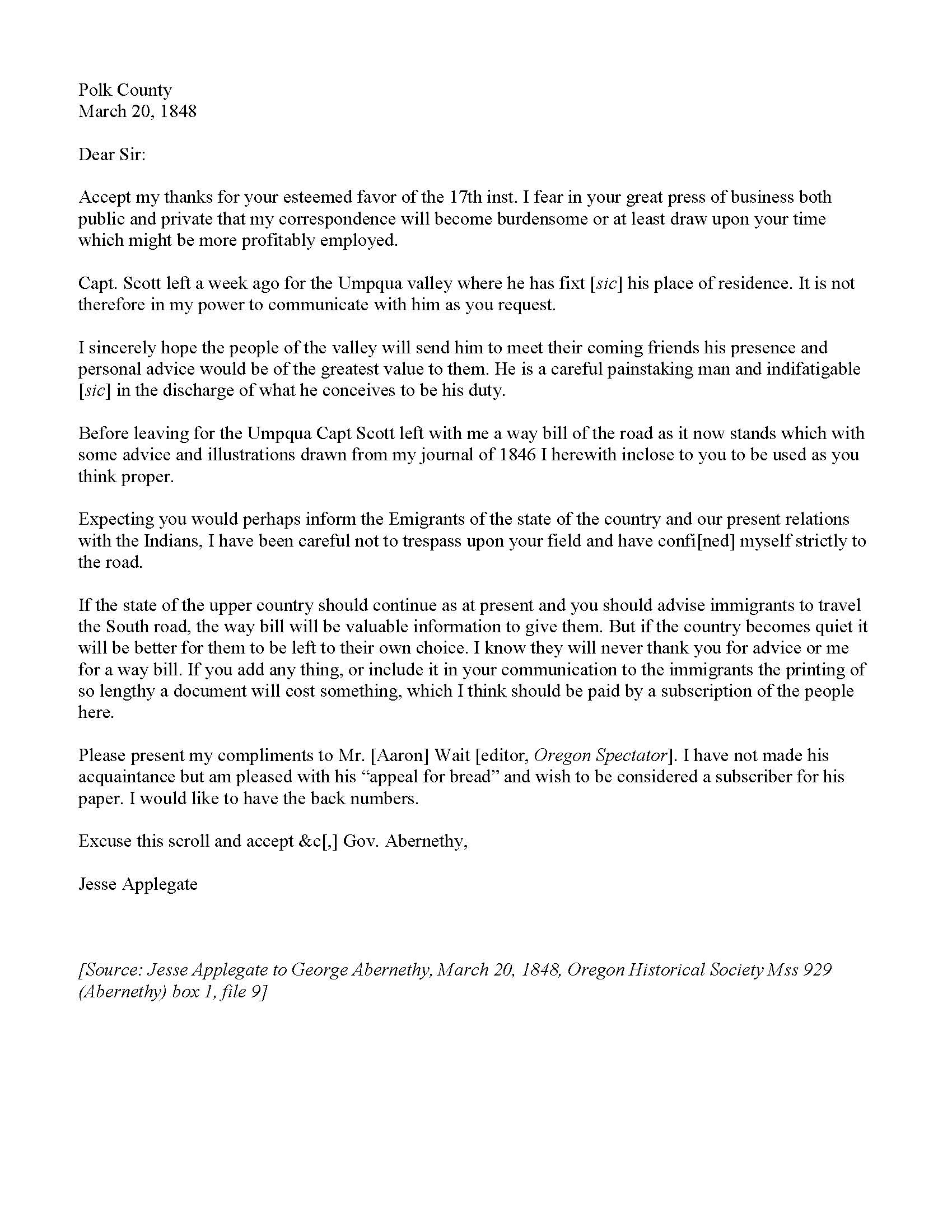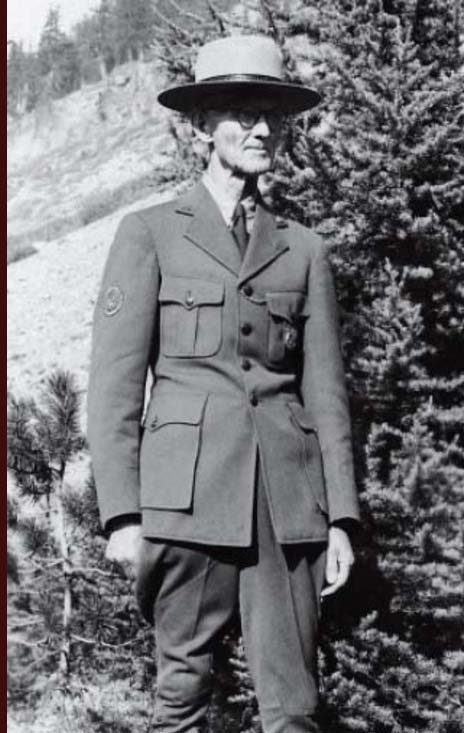Jesse Applegate, an influential early Oregon settler, is most remembered for his leadership role in establishing the Applegate Trail. Born in Kentucky on July 5, 1811, to Daniel and Rachel Lindsay Applegate, Jesse moved with his family to St. Louis in 1821. He was educated at Rock Springs Seminary in Shiloh, Illinois, where he learned surveying, and then worked for several years in the surveyor general’s office in St. Louis. In 1831, Applegate married Cynthia Ann Parker. The next year, they moved with their infant daughter (the first of twelve children) to St. Clair County, where he farmed and worked as a surveyor.
In spring 1843, Jesse Applegate, his brothers Charles and Lindsay, and their families began an overland journey to Oregon. They and other relatives joined a large wagon train of about a thousand people assembled near Independence, Missouri. The train, the first sizable group to travel the Oregon Trail, was later known as the Great Migration. The number of wagons in the train proved unwieldy, however, and it soon divided into two major units. Applegate was chosen captain of the slower train, known as the “cow column” because of its herds of stock. While making the dangerous trip down the Columbia River, one of the boats overturned, and Lindsay’s son Warren and Jesse’s son Edward drowned.
The Applegate families arrived at Fort Vancouver in November. They stayed near Salem in abandoned buildings at the Methodist Mission until after harvest in September 1844 and then moved to near present-day Dallas. In 1845, Jesse Applegate was elected as a delegate to the legislative assembly, where he had a leading role in forming a provisional government for Oregon.
Applegate and other residents believed that emigrants needed an easier and safer wagon route to the Willamette Valley. In early 1846, an exploring party failed to find a suitable southern route that would avoid the treacherous Columbia River. In late June, Jesse and Lindsay Applegate joined a second exploring and road-building party that sought to open a southern route. Jesse Applegate was elected captain of the party. The route that his party explored branched off from the California Trail and headed north from the Humboldt River through Nevada and northern California to the Willamette Valley. When they reached the California Trail along the Humboldt River in northwestern Nevada, Applegate traveled 350 miles east on the trail to Fort Hall where he arrived in August and promoted the new route.
In 1846, over two hundred people in about a hundred wagons followed Applegate's advice and turned onto the new trail. The result was a catastrophe. The route was not cleared or well marked, the terrain and road conditions were treacherous, Indians harassed the trains, and heavy rain and snow started unusually early in the season. Most of the emigrants reached the Willamette Valley by December, although some did not arrive until the next spring in spite of concerted rescue efforts. In addition to immense losses in property and animals, at least a dozen emigrants died.
While the route was improved over the next few years, it was never as successful as the shorter main route across the Columbia plateau. In spite of the criticism Applegate and the route received after the disastrous first season, it became known as the Applegate Trail for his role in exploring and promoting the route.
In 1849, Applegate moved his family to the Umpqua Valley in southwestern Oregon. He settled on a donation land claim and built a log cabin in a valley he named Yoncalla. His brothers Charles and Lindsay and their families soon settled nearby. Applegate farmed, planted a large orchard, and raised cattle. He had many business interests, including working occasionally as a surveyor, selling beef, operating a general store in his home, and he was appointed Yoncalla Valley postmaster. In 1858, he built a large two-story home on his property.
Applegate was active in Republican Party politics and wrote numerous letters expressing his political views, which were often published in the editorial pages of newspapers. In 1857, he was elected as a delegate to Oregon's constitutional convention, but he left the convention ten days later in frustration. At the Republican State Conventions in 1862 and 1864, Applegate nominated his friend Samuel E. May for Oregon secretary of state. After May was elected, Applegate signed the performance bonds for May for both terms of office; states often required such bonds for any officer who handled money, since the bond signer guaranteed that the officeholder was honest and the bond signer stood for the bonded individual.
In 1871, an investigation revealed that May had embezzled more than $12,000 during his terms. He was tried in criminal court and found not guilty. Civil action was brought against him, but by then he had left the state and was declared insolvent. After lengthy court proceedings, Applegate, as bond signer, was found liable for a large portion of the defaulted debt. He owed the state $5,793, and in the fall of 1874 all of Applegate’s land and his home were confiscated to cover the loss. He and his wife moved to the slope of Mount Yoncalla, building a small cabin on forty acres that their sons had deeded to her.
Over the next several years, Applegate also worked as a surveyor and as a hired hand until he eventually repaid the debt. After Cynthia died in 1881, he lived at the various homes of his children. He became irritable, combative, and difficult to control. In 1886, his son Robert had him committed to the state hospital for a year, after which he returned to living with his sons. He died on April 22, 1888, at the home of his son Alexander in Yoncalla.
-
Jesse Applegate.
A nephew of Jesse Applegate drew this likeness of his uncle from memory in 1908. Oreg. Hist. Soc. Research Libr., OrHi 45
-
![1988 photo of Coryell Pass marker, erected in 1911 by Oregon Lewis and Clark Chapter, D.A.R.]()
Coryell Pass marker, 1988.
1988 photo of Coryell Pass marker, erected in 1911 by Oregon Lewis and Clark Chapter, D.A.R. Univ. of Oreg. Libr., Architecture & Allied Arts Libr.
-
![Cover letter of March 20, 1848 from Jesse Applegate to Governor George Abernethy, accompanying waybill from Ft. Hall to the Willamette Valley.]()
Applegate, Jesse to Abernethy, transcript, Mar 20 1848.
Cover letter of March 20, 1848 from Jesse Applegate to Governor George Abernethy, accompanying waybill from Ft. Hall to the Willamette Valley. Transcription Stafford Hazelett
Related Entries
-
![Applegate House]()
Applegate House
The Charles and Melinda Applegate House in Yoncalla is the oldest known…
-
![Applegate Trail]()
Applegate Trail
The Applegate Trail, first laid out and used in 1846, was a southern al…
-
![Elmer Ivan Applegate (1867-1949)]()
Elmer Ivan Applegate (1867-1949)
Elmer Ivan Applegate was an important early Oregon botanist best known …
Related Historical Records
Map This on the Oregon History WayFinder
The Oregon History Wayfinder is an interactive map that identifies significant places, people, and events in Oregon history.
Further Reading
Applegate, Jesse. A Day with the Cow Column in 1843. Fairfield, Wash.: Ye Galleon Press, 1990. First published 1843 by The Caxton Club.
Lamar, Howard R., ed. The Reader’s Encyclopedia of the American West. New York: Harper & Row, 1977.
Neiderheiser, Leta Lovelace. Jesse Applegate: A Dialogue with Destiny. Mustang, Okla.: Tate Publishing, 2010.






